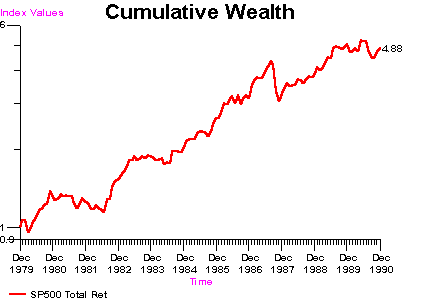MPPM540 Chapter 6
Post on: 29 Июль, 2015 No Comment

Chapter VI: The Arbitrage Pricing Theory
I. Holding the Security Market Line
No matter how theoretically appealing it may be, even the most ardent supporters of the Capital Asset Pricing Model admit the model does not quite fit reality. It is difficult to test the CAPM without data on the global wealth portfolio, and the S&P just won’t do. We know that some of the most obvious implications of the CAPM are violated — for instance, we all hold different portfolios. We are still in the dark about the more fundamental implications, such as the question of whether only systematic risk is priced. In the 1970’s, financial researchers took a different approach to the issue of identifying a discount rate for securities. This time, the security market line was the motivation for further theory.
Consider this — even if the CAPM is untrue, the security market line STILL remains an appealing diagram. The SML diagram contains the seeds to a different asset pricing model, called the Arbitrage Pricing Theory. The APT was developed by Stephen Ross. Like the CAPM, it argues that discount rates are based upon the systematic risk exposure of the security, as opposed to the total risk. Unlike the CAPM, it does not require that all investors behave alike, nor does it claim that the capital-weighted market portfolio i.e. the tangency portfolio, it the only risky asset that will be held.
II. Who Put the ‘A’ in the APT?
Consider a world where investors are broadly diversified, but there may be multiple sources of risk in the economy. Instead of everyone caring solely about the market portfolio, investors actually care about lots of things, including shifts in stock index levels, interest rates, inflation, changes in GNP or other broad macro-economic factors that are difficult to purge from your portfolio through diversification. For now, focus on one of these factors — the S&P 500. There is no need to presume that this or any factor matches the world wealth portfolio — it is just one source of risk that people care about.
Suppose, for argument’s sake, that security A plotted off the S&P 500 security market line. The CAPM says that it cannot, but what if it did? If everyone realized that A’s expected return was higher than B’s, then many of them would try to exploit such an opportunity. If A lies above the SML (whether in one dimension or several!) then this implies that A is underpriced given its beta. Investors will notice this, and will buy A. They may finance this purchase by selling (i.e. shorting) B, a portfolio with the same systematic risk.
In our example, the purchase of A by investors will drive up the price of A, reducing its expected return, and force it into the neighborhood of the security market line. In other words, deviations from linear pricing will be met swiftly by arbitrage. In fact, arbitrage in this context is a slight misnomer, because this investment strategy involves some risk. It is more properly terms an arbitrage in expectations because the investor is locking in a positive EXPECTED payoff, not a positive GUARANTEED payoff.
II.1 An Aside on Short-selling
Short-selling is a procedure that allows you to profit when the price of a security declines. In effect, it allows you to take a negative position in the security — just the opposite of a long position i.e. holding the security. To short a stock, you must borrow a share from someone who holds it (typically via your broker) and then promise to return the share of stock upon demand. Then you sell the share of stock. This activity has two effects. First, you get money from the sale of the share of stock. Second, you incur an obligation to return a share of the same stock in the future. If the stock price drops, you can fulfill your obligation by buying a share on the market for less that the price at which you shorted it. The more the price drops the more you profit. Of course, if the price rises, you lose.
III. Arbitrage in Expected Returns: An Example
Suppose you observed the following conditions:

- Risk-free bonds may be purchased at a cost of $100 (or in fractions if required). They are known to pay off in one year $110 with certainty.
- All investors can borrow and lend at the riskless rate.
- Shares of the market portfolio may be purchased for $100 each. They are expected to pay off $120 at the end of the year, but there is uncertainty involved. Shares of the market may be purchased and shorted without transactions costs.
- Shares of asset A may be purchased for $100 and they are expected by everyone to be worth $150 at the end of the year. Asset A has a beta of 1.3. As with the market, shares of A may be shorted and purchased without transactions costs.
How would an investor proceed in an expectations arbitrage?
First, calculate the expected return of asset A, under linear pricing model assumptions:
where Rf = the riskless rate
E[Rm ] = expected return on the market
The expected return in this case yields an expected future value which is lower than $150. This is a logical inconsistency if the index model were true. In practical terms it is underpriced.














